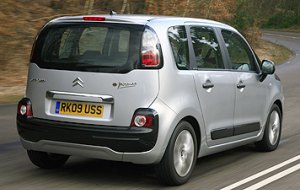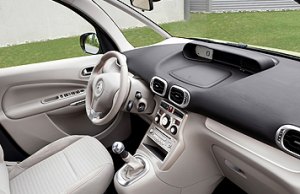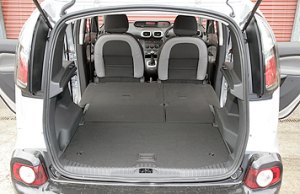|

|
Funky styling a sharp constrast to the
sophisticated C4 Picasso
|
Supermini-based
small MPVs have been popular since the pioneering Opel Meriva arrived
in 2003. While they seat no more than 5, they offer ample room and
flexible luggage space for a small family to spend their weekends
outside. That’s why more and more families trade their conventional
small cars for small MPVs, and therefore more and more manufacturers
join the battlefield. Citroen C3 Picasso is the latest entry into a
segment already occupied by Opel Meriva, Fiat Idea / Lancia Musa,
Renault Modus, Nissan Note, Toyota dB / Daihatsu Materia, Kia Soul,
Nissan Cube and Skoda Roomster.
Citroen said C3 Picasso replaces its 10-year-old Xsara Picasso, which
is time to retire later this year. You might question that C3 Picasso
is a class smaller than Xsara Picasso, just as their family names
suggested, so how can it replace the latter ?

|
Spacious enough to replace the larger
Xsara Picasso
|
Well, the C3 Picasso is really smaller than the old car. It is built on
the floorpan of Peugeot 207 (also the next generation C3), sharing the
latter’s 2540mm wheelbase and a length just over 4 meters. However, it
uses space very efficiently. Citroen designers gave its bodyshell a
boxy but rounded profile to maximize interior space. At the same time,
they managed to inject some style and fun into the minivan shape while
avoiding the weird looks of some rivals. Worth to note is that it has
no family resemblance at all with C4 Picasso, whose sophistication
contrasts the funky theme of the smaller car.
Open the doors, first to note is how airy its cabin feels. This is
contributed by the very high roofline (some 1624mm above ground) and
large glass area. Forward visibility is exceptional. Many
MPVs have front quarter blindspots caused by thick A pillars. Citroen
cleverly avoided this problem by moving the stress member to B-pillars,
hence possible to adopt very slim A-pillars and a pair of large quarter
windows. Such attention to details is rare to the French company, and
we expect many rivals will follow suit soon.

|
Slim A-pillars eliminates front
quarter blindspots
|
Apart from airy, the interior is spacious and flexible, too. High and
upright seating frees up legroom for all passengers so that 4 large
adults will find it comfortable for long journey. Like the most
flexible rivals, its 60/40-split rear bench can slide fore and aft
independently to vary the distribution of rear legroom and luggage
space, or simply fold onto the floor to reveal a totally flat luggage
area measuring 1506 liters, which is more accommodating than rivals.
Long items like surf boards can be placed with the front passenger seat
fold down. Moreover, there are plenty of small storage cubbies or
drawers all over the car. The Citroen makes no real breakthrough, but
it won’t lose marks to any rivals in terms of luggage utility.
Considering its affordable price, the C3 Picasso is pretty well made.
Although most plastics in the cabin are hard ones, the upper part of
dashboard is made of soft plastic, and the ventilation outlets have
classy metallic treatment. Fit and finish are up to class standard.
Most controls are well located and easy to reach. The only downside is
a centrally-mounted digital instrument panel, as we would prefer a
conventional one.

|
Luggage utility as flexible as anymore
else
|
As mentioned, the C3 Picasso is built on the platform of Peugeot 207,
which is a big improvement from the past. Refinement is evident in its
effective noise insulation, supple ride and smooth engines. In
particular, the BMW-developed 95hp 1.4-liter and 120hp 1.6-liter
engines are way smoother and freer revving than the outgoing PSA
engines, although they do not cope with the car’s 1.3 ton weight as
well as the 110hp 1.6HDI turbo diesel. Either way, C3 Picasso will not
be renowned for performance.
Neither will it be known for handling. Considering its tall body and
soft suspensions, its average body control is not a surprise. The same
goes for the light and vague steering. However, at least the car has
plenty of grip and a secured driving manner. After all, its main axis
are still comfort and ease of driving.
No one buys a mini MPV for its driving dynamics. What people are
looking for is the right combination of space, comfort, versatility and
packaging at the right price. Performance and handling are only bonuses
– although the MPVs of Ford did live on bonuses. From this viewpoint,
Citroen C3 Picasso may hit right the hearts of the buying public.
Undoubtedly, it is going to be a strong rival to the established
players in this segment. |